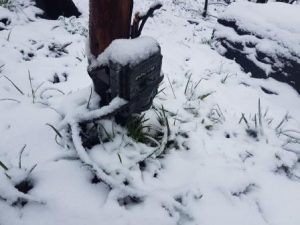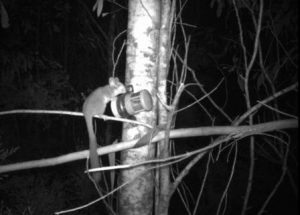Treetec ecologists and arborists are able to detect wildlife using remote thermal cameras in a range of forest types and habitats. We are able to modify our techniques to suit each individual client, the location and species involved. We are specialists in camera trapping arboreal wildlife using cameras high in the canopy. Contact us to assist in developing a solution for your project.

Camera trapping is a modern technique used by ecologists for scientific research. It is a very efficient way to collect data with minimal impact of the wildlife species being targeted. Cameras are installed using an odorous bait which entices animal activity directly in front of the camera but does not allow animals to consume the baits. The cameras are triggered using an infra-red sensor which recognises thermal changes when a warm-blooded animal enters the frame in which the camera is aimed. Cameras are left in situ for up to a month to record data both day and night for the entire period.
The Treetec team have extensive experience in camera trapping after years of working in Victoria’s forests. Wildlife assessments have been provided using camera trapping techniques for a range of stakeholders both government and private.

Our ecologists use both digital mapping and on ground surveys to select sites most likely to find the species targeted.
Whilst finding more common species on camera in their natural habitat is enjoyable, the main target is usually threatened or rarer species where hopefully their presence can be confirmed. Treetec ecologists use two main camera techniques depending on whether the target species is “terrestrial” i.e. ground dwelling or “arboreal” i.e. tree dwelling. Whilst ground cameras are reasonably easy to set up the arboreal cameras often require the assistance of Treetec arborists to climb and place the cameras at a relevant height and location to capture the targeted species – quite a specialist skill!

After cameras are returned from the forest all data is carefully stored and viewed by Treetec’s team of photo-tagging ecologists. Each photo is labelled as to what species is observed. Reports are written and relevant data on species identified are recorded, including adding records to the Victorian Biodiversity Atlas.
Much of Treetec’s work over the last years has involved camera trapping some of Victoria’s rarer and more threatened species including the Leadbeater’s Possum (Gymnobelideus leadbeateri), Smokey Mouse (Pseudomys fumeus), Broad-Toothed Rat (Mastacomys fuscus), Long-footed Potoroo (Potorous longipes), Long-nosed Bandicoots (Permameles nasuta), etc.
